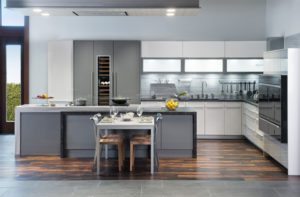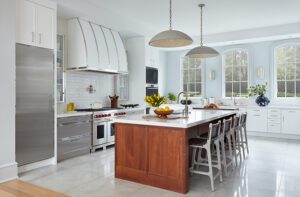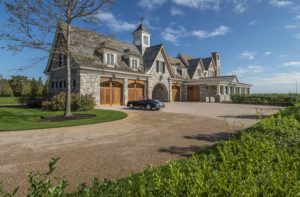High Style
December 29, 2014
An imaginative renovation returns a Back Bay Condominium to the sleek elegance the historic building deserves.
Text by Megan Fulweiler Photography by Michael J. Lee Produced by Kyle Hoepner

Anyone—or anything—that lives long enough will witness both good times and bad. Certainly the Vendome will attest to that. Once a posh hotel, built in 1872 in the elaborate French Second Empire style, the building has seen degradation, a devastating and tragic fire in the 1970s, and rebirth. Today, it is one of Boston’s grandest historic buildings, and its stylish condominiums (who would have imagined that in the nineteenth century?) are widely coveted today.
It took only minutes for the new occupants of this top-floor unit to imagine putting their stamp on the space. Enamored with the panoramic views, the central Back Bay location, and the lofty ceilings, they recruited local architect Carlos Ridruejo to help create a state-of-the-art home. The couple brought their own expertise to the project, as well: interior designer Craig Tevolitz is the owner of Platemark Design, and Richard Baiano is president and co-owner of the prestigious Childs Gallery.
The outcome was bound to be a showcase. There was just a bit of thorny path to navigate first.
The quirky warping that happens to all old buildings was to be expected. And the defining angles of the mansard roof made for an interesting challenge. But the structure’s interior integrity, compromised by previous remodels, was particularly worrisome. To craft a sturdy framework for the owners’ nest, the team at FBN Construction had to peel away the floor and gut the unit. “The owners and architect had an ultramodern and precise plan,” explains Bob Ernst, FBN’s president. “It was like building a perfect cube—a jewel box—inside a misshapen pumpkin.”
The design and building pros handled it all with aplomb. Every inch has been maximized, creating an airy ambience that belies the home’s modest size. Even the removal of an existing spiral stair and the installation of a sleek straight-run staircase—a bold maneuver demanding extra footage—managed to enhance the sense of spaciousness. The design’s intricacy, which required Ernst and his crew to mask utilities, integrate soffits to house lighting, and marry disparate materials, allowed no room for imperfections.
The architecture and decor are a testament to the host of talents involved. Tevolitz’s knack for wielding fabrics and color makes itself apparent at the very threshold. To mask the entry’s surplus of doors, for instance, he wrapped the entire space in a dreamy Lee Jofa chinoiserie fabric. Hardware is banished. Instead, the powder-room door protrudes slightly forward, providing just enough room for a hand to gently pry open the panel. With that, lights automatically pop on, illuminating a streamlined travertine sink.
Move farther into the apartment and the main living area, as Tevolitz explains, “reveals itself.” Up soars the aura of light and the level of drama. An ingenious sculptural wall composed of a series of three-dimensional boxes with diamond-shaped edges angling out is at the heart of Ridruejo’s masterly composition. No mere attention-grabbing focal point, this glossy geometric wall serves a number of roles. Almost magically, some cubes slide open, allowing access to a stunning dry bar; others swivel lazy-Susan fashion to expose the TV.
As glamorous as the home is, it’s also eminently livable. “There’s a great level of comfort,” says Baiano. “It may look formal, but it’s also flexible.”
Tevolitz designs his interiors with real-life events in mind. How people will interact dictates that furnishings be both chic and relaxing. For example, a John Saladino Tuscan sofa clad in chenille and Balinese batik is “deep and sheltering,” says Tevolitz, while a vintage coffee table nearby makes an attractive and easy-to-reach spot to rest a cocktail.
Adding richness to this urban setting is the remarkable art. The heady blend of styles and periods—a circa-1957 Edward Laning oil over the sofa, say, with a 1930s Alfred Maurer as neighbor—keeps the eye interested and engaged. Thanks to a discreet click-rail system, paintings are shuffled in and out all the time, the owners say, for an ever-changing, spirit-lifting roster.
As happy sharing their home as they are having it to themselves after an über-busy day, the couple stage regular dinner parties. Tevolitz, as it turns out, is also an accomplished cook. Pulled pork with homemade buttermilk biscuits is just one of his many go-to dishes. So primed for entertaining is the layout, though, that if it weren’t for the intoxicating aromas, guests might wonder where meal prep takes place. The elegant kitchen—a medley of highly organized cabinetry and lush materials—seamlessly partners with the nearby pear wood dining table.
In step with Ridruejo’s concept, kitchen designer Donna Venegas, owner of Boston’s Venegas and Company, skillfully concealed the refrigerator, freezer, and pantry in a nine-by-eleven-foot niche opposite the sink. “It was a challenge, but it doesn’t lack a thing,” she says. When the retractable doors are closed, no one guesses at the marvels (or mess) hidden behind.
To ensure that the everything-is-perfect tempo transitions without disruption to the master suite, the first few steps on the carpeted staircase are framed with glass. The see-through railing helps link the stairs with the main living area. But then the sculptural wall that rises with the stairs performs some more tricks. Along the way, a handful of cubes become display shelves for mementos and prints. And once in the bedroom, the chameleon-like wall presents itself as a bookshelf.
A core part of the men’s art collection is their trove of black-and-white photographs, many of which they display here so they can see them first thing in the morning, last thing at night. As plush as downstairs, the private quarters—meticulously planned marble-tiled master bath and dressing area included—exude sophistication.
Who can blame these owners for never wanting to leave the stellar abode they’ve contrived? “We don’t really enjoy hotels like we used to,” admits Tevolitz. “Everything we need is here.” •
Architecture: Carlos Ridruejo, Caridossa
Interior Design: Craig Tevolitz, Platemark Design
Builder: FBN Construction
Kitchen Designer: Donna Venegas, Venegas and Company
Share
![NEH-Logo_Black[1] NEH-Logo_Black[1]](https://www.nehomemag.com/wp-content/uploads/2022/08/NEH-Logo_Black1-300x162.jpg)


















You must be logged in to post a comment.